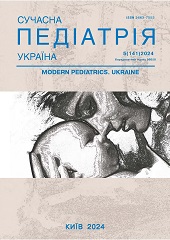Extrahepatic portal vein obstruction in children. The diagnosis is established - what is next?
DOI:
https://doi.org/10.15574/SP.2024.5(141).1622Keywords:
extrahepatic portal vein obstruction, bleeding esophageal varices, primary prevention, endoscopic variceal ligation, surgical treatment indications, childrenAbstract
Extrahepatic portal vein obstruction (EHPVO) is the most common cause of portal hypertension in children, the most life-threatening manifestation of which is variceal bleeding, with a mortality rate of 4-19%.
The aim of the study is to determine the treatment tactics for children with symptomatic portal hypertension from the moment of diagnosis of EHPVO, indications for the endoscopic prevention and surgical procedures; to study the risk factors that influence the esophageal variceal bleeding to become the first sign of EHPVO.
Materials and methods. The data of patients, which was collected retrospectively from 245 case histories between January 2011 and January 2022, revealed 55 (22.4%) children with EHPVO, who had not undergone surgical procedures. The median follow-up period was 25 (95% CI 20-35) months. Statistical analysis was performed using IBM SPSS for Windows version 24.0 and EZR(R-statistics). A P-value˂0.05 was considered statistically significant. Scheffe’s method, Kruskal-Wallis and Dunn’s tests were used to compare the follow-up results. Chi-square test was used to assess varices grade dynamics.
Results. The mean age of patients in the group was 5.1±0.54 years, 34 (61.8%) patients were males. 36 (65.5%) patients had complicated delivery with subsequent umbilical catheter insertion. 27 (47.1%) patients manifested bleeding episodes. Endoscopic ligation showed good results in improving varices grade (p<0.001). The logistic regression model identified factors connected to the bleeding risks: “way of delivery” (p=0.027) and “hemoglobin level” (p=0.0015). Indications for surgical intervention were failure to decrease the esophageal varices grade (n=4; 7.2%) and an increase in the volume of the spleen with thrombocytopenia progression (n=6; 10,9%).
Conclusion. The most careful medical attention to babies of the risk group is required. Endoscopic ligation has shown good results in variceal grade decrease. Indications for surgical treatment are failure to decrease the grade of esophageal varices, an increase in the volume of the spleen with thrombocytopenia progression.
The research was carried out in accordance with the principles of the Declaration of Helsinki. The research protocol was approved by the Local Ethics Committee of the participating institution. The informed consent of the patient was obtained for conducting the studies.
No conflict of interests was declared by the authors.
References
Bambini DA, Superina R, Almond PS, Whitington PF, Alonso E. (2000). Experience with the Rex shunt (mesenterico-left portal bypass) in children with extrahepatic portal hypertension. Journal of pediatric surgery. 35(1): 13-19. https://doi.org/10.1016/S0022-3468(00)80005-6
Carollo V, Marrone G, Cortis K, Mamone G, Caruso S, Milazzo M et al. (2019). Multimodality imaging of the Meso-Rex bypass. Abdominal radiology (New York). 44(4): 1379-1394. https://doi.org/10.1007/s00261-018-1836-1
Chaudhary N, Mehrotra S, Srivastava M, Nundy S. (2013). Management of bleeding in extrahepatic portal venous obstruction. International journal of hepatology. 2013: 784842. https://doi.org/10.1155/2013/784842
Chiou FK, Abdel-Hady M. (2017). Portal hypertension in children. Paediatrics and Child Health. 27(12): 540-545. https://doi.org/10.1016/j.paed.2017.08.005
Dos Santos JMR, Ferreira AR, Fagundes EDT, Ferreira APS, Ferreira LS, Magalhães MCR et al. (2013). Endoscopic and Pharmacological Secondary Prophylaxis in Children and Adolescents With Esophageal Varices. Journal of Pediatric Gastroenterology and Nutrition. 56(1): 93-98. https://doi.org/10.1097/MPG.0b013e318267c334
Duché M, Ducot B, Ackermann O, Guérin F, Jacquemin E, Bernard O. (2017). Portal hypertension in children: High-risk varices, primary prophylaxis and consequences of bleeding. Journal of hepatology. 66(2): 320-327. https://doi.org/10.1016/j.jhep.2016.09.006
Flores-Calderón J, Morán-Villota S, Rouassant S-H, Nares-Cisneros J, Zárate-Mondragón F, González-Ortiz B et al. (2013). Guidelines for the diagnosis and treatment of extrahepatic portal vein obstruction (EHPVO) in children. Annals of Hepatology. 12: S3-S24. https://doi.org/10.1016/S1665-2681(19)31403-6
Giouleme O, Theocharidou E. (2013). Management of portal hypertension in children with portal vein thrombosis. Journal of pediatric gastroenterology and nutrition. 57(4): 419-425. https://doi.org/10.1097/MPG.0b013e3182a1cd7f
Godik O, Diehtiarova D. (2023). Rex shunt in children: could dysfunction be prognosed? A retrospective analysis. Wiadomosci Lekarskie (Warsaw, Poland: 1960). 76(12): 2579-2586. https://doi.org/10.36740/WLek202312105
Godik OS, Voroniak DI, Diehtiarova DS. (2023). The role of variceal bleeding primary prophylaxis in the management of extrahepatic portal vein obstruction in children. Paediatric surgery (Ukraine). 4(81): 24-30. https://doi.org/10.15574/PS.2023.81.24
Khodayar-Pardo P, Peña Aldea A, Ramírez González A, Meseguer Carrascosa A, Calabuig Bayo C. (2016). Very Early Presentation of Extrahepatic Portal Vein Obstruction Causing Portal Hypertension in an Infant: Uncertainties in the Management and Therapeutic Limitations. Case reports in gastroenterology. 10(2): 360-365. https://doi.org/10.1159/000447485
Sarin SK, Kumar A. (1989). varices: profile, classification, and management. Am J Gastroenterol. 84(10): 1244-1249.
Shneider BL, Bosch J, de Franchis R et al. (2012). Expert Panel of the Children's Hospital of Pittsburgh of UPMC. Portal hypertension in children: expert pediatric opinion on the report of the Baveno V consensus workshop on methodology of diagnosis and therapy in portal hypertension. Pediatr Transplant. 16(5): 426-437. https://doi.org/10.1111/j.1399-3046.2012.01652.x
Young V, Rajeswaran S. (2018). Management of Portal Hypertension in the Pediatric Population: A Primer for the Interventional Radiologist. Seminars in interventional radiology. 35(3): 160-164. https://doi.org/10.1055/s-0038-1660794
Downloads
Published
Issue
Section
License
Copyright (c) 2024 Modern pediatrics. Ukraine

This work is licensed under a Creative Commons Attribution-NonCommercial 4.0 International License.
The policy of the Journal “MODERN PEDIATRICS. UKRAINE” is compatible with the vast majority of funders' of open access and self-archiving policies. The journal provides immediate open access route being convinced that everyone – not only scientists - can benefit from research results, and publishes articles exclusively under open access distribution, with a Creative Commons Attribution-Noncommercial 4.0 international license (СС BY-NC).
Authors transfer the copyright to the Journal “MODERN PEDIATRICS. UKRAINE” when the manuscript is accepted for publication. Authors declare that this manuscript has not been published nor is under simultaneous consideration for publication elsewhere. After publication, the articles become freely available on-line to the public.
Readers have the right to use, distribute, and reproduce articles in any medium, provided the articles and the journal are properly cited.
The use of published materials for commercial purposes is strongly prohibited.

